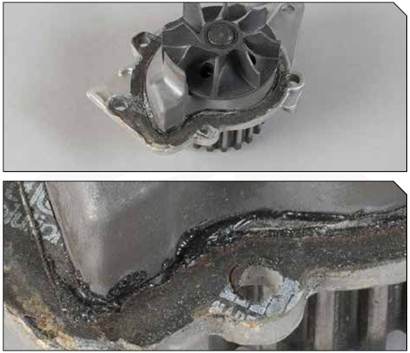The water pump is the heart of the engine’s cooling system. It is the water pump’s job to constantly circulate the coolant throughout the entire cooling circuit and thus regulate the coolant flow rate. Wear affects not only the hoses and thermostat but also the water pump.
The average water pump handles 1.7 million litres of coolant in about four years or 100,000 km of driving. But pumps can fail faster, and a failing pump can cause an engine to overheat. Therefore, it is important to check the water pump at each service interval. But it is equally important to inspect the belt drive system that is driving the water pump. A malfunctioning belt and tensioner cause premature bearing and shaft failure and as such drastically reduce pump life. Conversely, a leaking water pump inevitably affects the belt and tensioner. That is why Gates recommends changing the water pump, belt and other drive components at the same time as good preventive maintenance.
There are 7 key signs which indicate that a water pump needs to be replaced. Below are 2 of the 7 signs.
1. Weep hole leakage
Appearance: The pump’s internal mechanical seal seals the shaft towards the cooling circuit, protecting the bearings by preventing coolant from passing into the bearing assembly. When a water pump is new, some seepage from the weep hole is normal as it takes about ten minutes of operation for the mechanical seal to properly seat itself (break-in period). More pronounced seepage and drips from the weep hole after this break-in period or a large coolant bleed mark around the weep hole are abnormal and indicate impending water pump failure.
Cause: Contaminated coolant is the main cause of leakage: any contaminant (abrasive particles, engine oil…) present in the coolant that scratches the mechanical seal or affects its wear resistance creates a path for coolant leakage. Also, never dry run a water pump, not even for a few seconds. Dry running of the pump ruins its mechanical seal.
Solution: Any leakage from the weep hole after the break-in period means the water pump must be replaced immediately. It is very important to thoroughly flush the cooling system before installing the new pump and to refill the system with the correct vehicle manufacturer’s recommended coolant.
2. Leakage from the mounting surface

Appearance: Seepage, drips or large coolant bleed marks on or around the mounting surface or on the housing.
Cause: Improper water pump installation, e.g. wrong torque of the mounting bolts. Improper use of seals/gaskets or sealant, e.g. unevenly applied sealant.
Solution: In case of a recently installed new water pump: carefully remove, check and re-install the water pump. Strictly follow the torque specifications. Make sure seals/gaskets are in perfect condition and are installed correctly. When sealant is prescribed, clean the rims of the part and the mounting surface from old sealant remains and apply new sealant evenly along the edge of the part. If the leakage is not the consequence of an improperly installed new water pump, the pump must be replaced immediately.